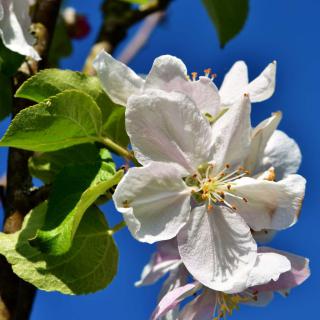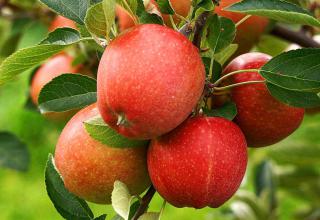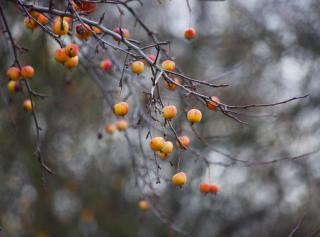The apple tree is among the most common fruit trees found in our orchards.
A summary of Apple tree facts
Name – Malus communis
Family – Rosaceae
Type – fruit tree
Height – 16 to 32 feet (5 to 10 m)
Climate – temperate
Exposure – full sun
Soil – rich, well drained
Foliage – deciduous – Flowering – spring – Harvest – Autumn
Planting an apple tree
Fall is the best season for planting apple trees, as this lets the tree develop a sufficient root system before the onslaught of winter.
It is also possible to plant the tree anytime from fall to spring, as long as it isn’t done during frost spells; it is also possible during the summer except during heat waves.
When planting in spring and in summer, ensure regular watering.
- An apple tree requires sunlight to bloom and produce apples.
- It likes well drained soil.
- Adding fertilizer such as manure and seaweeds during planting will help the tree to take root.
- Water your apple tree regularly for the two first years after planting.
- To promote root growth, follow our recommendations on planting trees and shrubs.
Pollinating an apple tree
 Generally, apple trees are not self-pollinating, meaning that if you wish to have apples, you’ll need to plant at least 2 apple trees.
Generally, apple trees are not self-pollinating, meaning that if you wish to have apples, you’ll need to plant at least 2 apple trees.
- Fertilization must take place between two distinct trees at least for the flowers to develop into fruits.
If you lack space to plant more than one apple tree, choose a self-pollinating variety such as: ‘Charles Ross’, ‘James Grieve’, ‘Egremont Russet’, ‘Arthur Turner’ or ‘Red Falstaff’.
- Note that planting only one variety, even if it is self-pollinating, might produce a smaller harvest than if you plant several varieties together.
Planting, pruning, and caring for an apple tree
In order to coax the tree into producing many beautiful apples, it is important to perform a fruit-inducing pruning before spring growth has started.
Pruning your apple tree should hence take place at the end of winter, when freezing no longer occurs.
- Adding special fruit tree fertilizer in spring boosts yields. Add a good-sized handful of fertilizer granules and rake them lightly into the surface of the soil.
- It is important to water regularly during the first 2 years after planting.
- Look up more information on the different pruning stages over the apple tree’s life cycle.
Preserving apples during winter
Apple tree diseases
Apple trees, like most fruit trees, are vulnerable to several common diseases, like fungus.
The most common apple tree diseases are scab and apple rot.
Apple scab
If an onslaught appears at the end of the cycle, when apples are already well-formed, degradation is limited and perhaps only a slight coloration of the apples may be observed. The harvest is not lost, but it is more difficult to keep the apples
However, if scab appears early in the season, it is recommend to treat it in order to stop the spread of the disease. An early onslaught of scab may hinder fruit development and compromise the harvest.
- A regular application of fermented stinging nettle tea as soon as buds have formed on the apple tree can prevent scab altogether.
- Spraying with Bordeaux mixture also protects against the spread of scab.
- There are a number of efficient chemical scab-fighting fungicides, both preventive or curative, but it is best to use them only once scab has already invaded the apple tree.
- Do not treat if you are only a few weeks from harvest.
- At the end of the season, gather all the leaves and destroy them to avoid letting scab hibernate in your garden over the winter.
- Read our page dedicated to fighting scab
European Brown rot
Another common ailment of apple trees is European brown rot, where Monilinia fungus strands rot fruits while still on the branch. This fungus can cause extensive damage to the apple tree and it is preferable to prevent it altogether.
Insects and parasites: aphids, scale insects…
If you observe that leaves of your apple tree become sticky and roll themselves up, you are certainly faced with an onset of either aphids or scale insects.
- Here is how to fight aphids
- Here is how to fight scale insects
- Set up pheromone traps in the tree
- A collar of sticky glue wrapped around the trunk protects the tree from many insects that would otherwise set up shop in the tree and on its leaves.
Species and varieties of apples
Harvest from September to December
- ‘Red Astrakhan’ – ripens end of August, keeps until October. Resists strong cold. Good fruit, average size. Best when eaten at time of harvest.
- ‘Belle de Boskoop’ – ripens in December, keeps until February. Vigorous, ideal for cold and damp climates. Huge fruit, a bit tart.
 ‘Chantecler (Belchard)’ – ripens in September, keeps until November. Smooth flesh, crisp, tart. Blooms late, is well adapted to cold climates.
‘Chantecler (Belchard)’ – ripens in September, keeps until November. Smooth flesh, crisp, tart. Blooms late, is well adapted to cold climates.- ‘Cox Orange Pippin’ – ripens in October, keeps until January. Average caliber, sweet fruit, must be pruned to low, flat shapes since it is a weak variety.
- ‘Delbarestivale’ – ripens in August, keeps until October. Big fruit, crisp flesh, slight taste of licorice or aniseed. For semi-free tree shapes.
- ‘Florina (Querina Florina)’ – ripens in October, keeps until February. Resists diseases very well. Firm flesh, slightly tart, cultivate in windy locations.
- ‘Grand Alexander’ – ripens in September, keeps until October. Eat quickly, can be pruned to all tree shapes. Pleasant fruit, juicy, crisp.
- ‘Idared’ – ripens in October, keeps until February. Keeps very well, smooth flesh, soft, sweet. Quite vulnerable to powdery mildew.
- ‘King of the Pippins’ – ripens in November, keeps until December. Strong and productive. Adapted to all climates, ideal for free-form tree shapes.
- ‘Royal Gala’ – ripens in October, keeps until February. Productive and vigorous. Meaty fruit, crisp, excellent.
- ‘Starkrimson’ – ripens in October, keeps until December. Productive and hardy. Bears fruit very young. Slightly mealy flesh.
- ‘White Transparent’ – ripens in August, keeps until September. Very good fruit, tangy. Eat quickly, as fruits fall off the tree too easily.
Harvest from December to March
- ‘Calville Blanc d’Hiver’ – ripens in November, keeps until February. One of the best! Big fruit, vulnerable to scab.
- ‘Delbard Jubilee’ – ripens in October, keeps until February. Resists diseases well. Can be shaped to espalier patterns.
- ‘Gloster’ – ripens in October, keeps until March. Excellent fruit, vigorous tree. Bears fruit very young. Perfect for pastries.
- ‘Golden Delicious’ – ripens in December, keeps until March. Ideal for cold climates. Tasty when grown in a garden.
- ‘Granny Smith’ – ripens in November, keeps until March. One of the tangiest. The best apple for low-cholesterol diets.
- ‘Jonagold’ – ripens in November, keeps until January. Very vigorous tree, productive. Relatively tender flesh. Quite vulnerable to powdery mildew.
- ‘Jonathan’ – ripens in November, keeps until January. Big fruit, soft flesh. Bears fruits very young. Adapted to windy locations.
- ‘Ontario’ – ripens in January, keeps until March. Average vigor. Espalier patterns. Melting flesh, delicate.
- ‘Canadian Reinette’ – ripens in December, keeps until February. Very fragrant flesh. Appreciates damp climates and high altitudes, up to 3 300 feet (1 000 m).
- ‘Reinette Clochard’ – ripens in December, keeps until March. Perfect for west France. Cultivate in semi-free tree shapes. Firm flesh, juicy, tart.
- ‘Reinette Grise du Canada’ – ripens in December, keeps until February. Good vigor, tree tends to bear in alternate years. Rather soft flesh, very fragrant.
- ‘Winter Banana’ – ripens in November, keeps until January. Smells slightly of bananas. Very fertile, good pollinator. Grows well in cordon espalier shapes.
Learn more about apple trees
 Apple trees are often cultivated for the quality of their fruits, but also simply for its very decorative value beginning of spring. Indeed, ornamental apple trees are very trendy in many urban landscapes.
Apple trees are often cultivated for the quality of their fruits, but also simply for its very decorative value beginning of spring. Indeed, ornamental apple trees are very trendy in many urban landscapes.
Its beautiful blooms are magnificent, ranging in color from pure white to pink-shaded white.
Towards summer’s end, apples’ rich colors will also enchant your garden and fill your appetite!
In winter, tardy apple tree varieties will display their fruits for all to see.
Caring for them is easy and growing them is something every gardener can do well!
From the end of summer deep into fall, harvest your apples for a natural treat, eat them baked in pies or in applesauce. They’re delicious also prepared in jams.
Smart tip about apple trees
In order to enhance apple trees’ yields, especially at the beginning, give it organic soil conditioner such as manure and seaweed in fall and in spring.
©MazurTravel


 Generally, apple trees are not self-pollinating, meaning that if you wish to have apples, you’ll need to plant at least 2 apple trees.
Generally, apple trees are not self-pollinating, meaning that if you wish to have apples, you’ll need to plant at least 2 apple trees. ‘Chantecler (Belchard)’ – ripens in September, keeps until November. Smooth flesh, crisp, tart. Blooms late, is well adapted to cold climates.
‘Chantecler (Belchard)’ – ripens in September, keeps until November. Smooth flesh, crisp, tart. Blooms late, is well adapted to cold climates. Apple trees are often cultivated for the quality of their fruits, but also simply for its very decorative value beginning of spring. Indeed, ornamental apple trees are very trendy in many urban landscapes.
Apple trees are often cultivated for the quality of their fruits, but also simply for its very decorative value beginning of spring. Indeed, ornamental apple trees are very trendy in many urban landscapes.